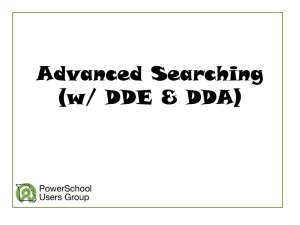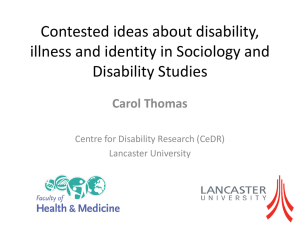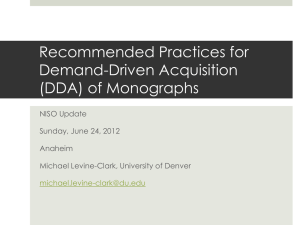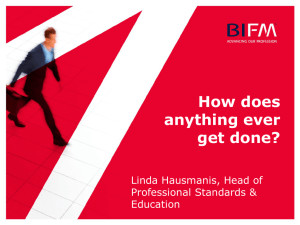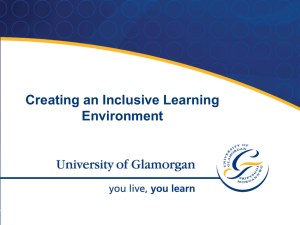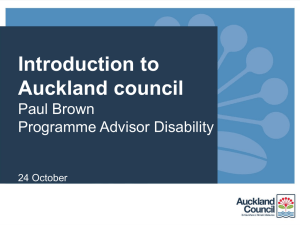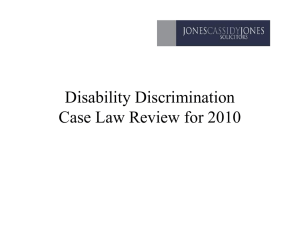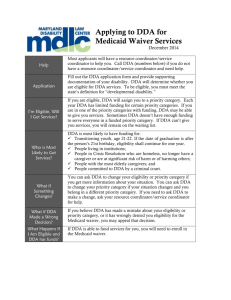BIFM Workshop at Education Resources and Facilities Forum
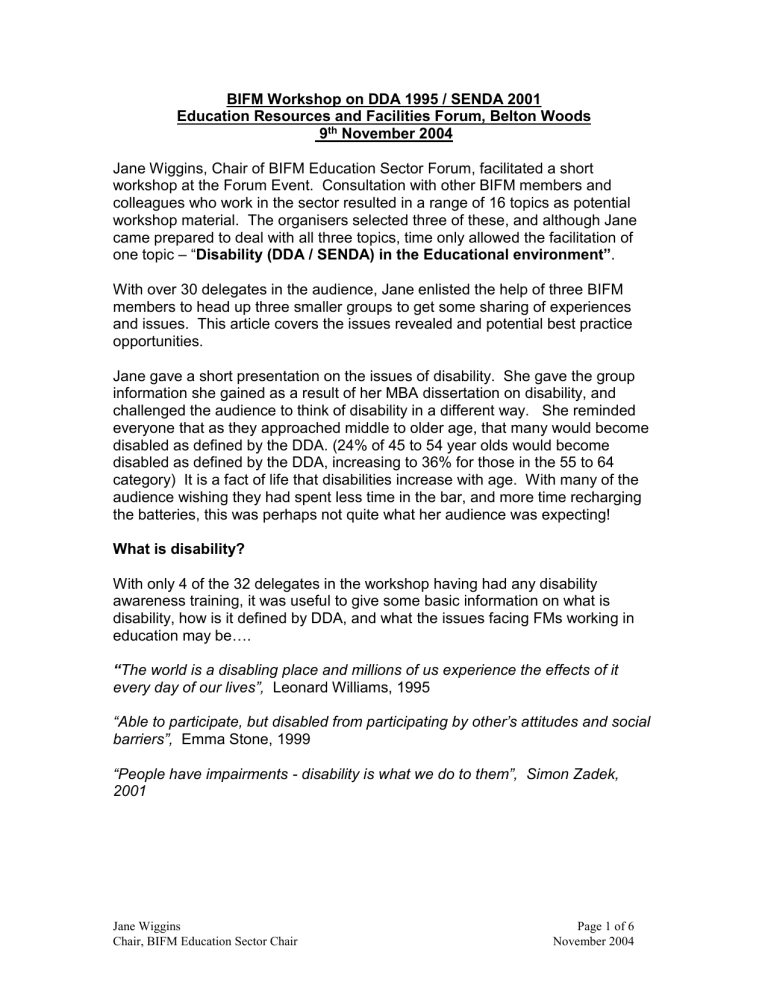
BIFM Workshop on DDA 1995 / SENDA 2001
Education Resources and Facilities Forum, Belton Woods
9 th November 2004
Jane Wiggins, Chair of BIFM Education Sector Forum, facilitated a short workshop at the Forum Event. Consultation with other BIFM members and colleagues who work in the sector resulted in a range of 16 topics as potential workshop material. The organisers selected three of these, and although Jane came prepared to deal with all three topics, time only allowed the facilitation of one topic – “ Disability (DDA / SENDA) in the Educational environment ” .
With over 30 delegates in the audience, Jane enlisted the help of three BIFM members to head up three smaller groups to get some sharing of experiences and issues. This article covers the issues revealed and potential best practice opportunities.
Jane gave a short presentation on the issues of disability. She gave the group information she gained as a result of her MBA dissertation on disability, and challenged the audience to think of disability in a different way. She reminded everyone that as they approached middle to older age, that many would become disabled as defined by the DDA. (24% of 45 to 54 year olds would become disabled as defined by the DDA, increasing to 36% for those in the 55 to 64 category) It is a fact of life that disabilities increase with age. With many of the audience wishing they had spent less time in the bar, and more time recharging the batteries, this was perhaps not quite what her audience was expecting!
What is disability?
With only 4 of the 32 delegates in the workshop having had any disability awareness training, it was useful to give some basic information on what is disability, how is it defined by DDA, and what the issues facing FMs working in education may be ….
“The world is a disabling place and millions of us experience the effects of it every day of our lives”, Leonard Williams, 1995
“Able to participate, but disabled from participating by other’s attitudes and social barriers”,
Emma Stone, 1999
“People have impairments - disability is what we do to them”, Simon Zadek,
2001
Jane Wiggins
Chair, BIFM Education Sector Chair
Page 1 of 6
November 2004
So who are affected by the DDA?
Disability Triangle
DDA severely disabled not recorded as disabled, but in pain and discomfort - not able to perform as freely as others able-bodied - those at risk for future disabilities
Jane gave the delegates a brief comparison on how disability is viewed, with some academic theory on disability. Useful for those FMs having to deal with academics in the workplace!
Jane Wiggins
Chair, BIFM Education Sector Chair
Page 2 of 6
November 2004
Diversity or Equal Opportunities?
Jane suggested to the group that it was more appropriate to consider diversity and inclusion in policies and procedures, rather the former equal opportunities viewpoint. Below is a comparison to show how diversity management gives a more holistic approach.
Disability Discrimination Act and SENDA
How is this law different to the H, S and E law?
DDA and SENDA are not criminal law. The government or appointed officers cannot prosecute for a breach. It is civil law and therefore requires case law to establish precedents. A claimant has to prove there is a wrong doing, or tort, committed by a third party. The Disability Rights Commission, DRC, is now actively supporting claimants to ensure that case law is established.
Consider the relationship between educational establishment and their students / pupils… is this a duty of care between two parties? If so, there are implications in terms of your responsibility as the “master” in a master/servant relationship.
So how can you comply with DDA or can you? Jane asked the delegates to consider these questions.
Can your buildings be compliant?
Are your contractors, suppliers and providers compliant?
Can you, as a FM, be compliant?
Can your processes, procedures and policies be compliant?
Managing Dive rsity
1 ensures all students maximise their potential and their contribution to the organisation
2 embraces a broad range of people; no one is excluded
Equal Opportunitie s concentrates on discrimination is perceived as an issue for women, ethnic minorities, and people with disabilities concentrates on the numbers of groups employed
3 concentrates the culture of an organisation, and the meeting of business objectives
4 is the concern of all employees, students, customers, contractors, suppliers, and key stakeholders
5 does not rely on positive action/ affirmative action is seen as an issue to do with
Personnel and Human Resource practitioners relies on positive action
Jane Wiggins
Chair, BIFM Education Sector Chair
Page 3 of 6
November 2004
Whilst there is a lot of focus on trying to get the physical environment to be compliant, and there are a lot of companies selling their products and services to help in this regard, it may be impossible to make a building “compliant” in terms of DDA. It is important however to ensure that health and safety issues are not used as a defence for not implementing an adjustment. DDA is about being proactive, take positive steps to reduce / eliminate discrimination. An audit is a useful first step, but care is needed that this is not just a look at access, and the processes, procedures, policies in an end to end relationship (from recruitment to examination / graduation) are considered.
For those educational establishments that offer their facilities to the public and the community at large, then the wider implications of providing services must be considered too.
How is a disability defined ?
Disabled person is someone who may have …
physical / mental impairment
Mobility, manual dexterity, physical co-ordination
Continence
Ability to lift, carry or move every day objects
Speech, hearing, eyesight
Memory, ability to concentrate, learn or understand
Perception of risk or physical danger
the impairment must adversely affect ability to carry out normal day-to-day activities
the adverse effect must be substantial and long term (ie over 12 months)
Discrimination
People disabled under the definitions of DDA, must be able to gain access to range of activities, including employment, services, education, transport, goods and facilities. A disabled person cannot be treated less favourably for a reason that relates to their disability.
A duty to who?
Public, Employees, Students / pupils (16+)
A duty to do what?
Develop, implement, review your accessibility strategy
Do not wait for the need for a change, be proactive, and be ready to make the adjustments needed.
Consider disability discrimination in an educational setting
Access - physical, mental, social. D on’t just focus on the physical barriers….
Mental and social barriers are just as important for access to education.
Jane Wiggins
Chair, BIFM Education Sector Chair
Page 4 of 6
November 2004
Attitudes, prejudice and assumptions. Disabled people are intelligent and very experienced in overcoming adversity. Consult them, they will give you lots of help to solve jointly any problems. Remember that less than 5% of disabled people use wheelchairs; only 1% of visually impaired can read
Braille; 0.5% of deaf people can use BSL, with 22% using hearing aids.
(source RNIB and RNID web sites)
Inclusive - design, flexibility, whole transaction (end to end). Consider the benefits to all of us in the community of better inclusive design. The use of dropped kerbs has benefited parents with pushchairs, travellers with pull along bags; consider benefits of fire doors propped open on retainers for those carrying bags or equipment; consider the benefits of adjustable workstations for those of below average or above average height or weight;
The use of learning contracts or agreements. With only one delegate in the audience using learning agreements, there is scope for this important tool to be shared within the sector that will help the FMs and academic staff working together to ensure reasonable adjustments are made under DDA.
Adjustments / auxiliary aids and services e.g. support staff, dyslexia tutors, special equipment, time-tabling accessible rooms,
Confidentiality of information – the need to know basis. Once an organisation has been informed, then it is deemed that whole organisation knows. That is, the student need not advise anyone else. Policy needs to be in place to ensure that this kind of information is shared in a confidential and need to know basis.
Resources / funding
– making best use of funds, and grants to provide the adjustments that may be required.
Adjustments - what is 'reasonable’? You need to consider…
Cost
Practicality
The availability of services/aids from other sources
Health and Safety
The interests of other students
Academic standards
The institutions' resources
Other financial resources or services available to the student
In the group work, facilitated by three BIFM delegates, Jane posed these questions:-
What have you done to meet the challenges of compliance to DDA / SENDA?
What have you learnt that could be of benefit to others?
How did you approach the challenge?
Could you do more?
Success stories?
Sharing knowledge and experiences?
Jane Wiggins
Chair, BIFM Education Sector Chair
Page 5 of 6
November 2004
Examples of activities carried out by delegates included
1. Physical alternations to the building (s)
2. Appointment of an individual as the SENDA nominated representative or key member of staff
3. Establishment of a Disability Review Committee
4. Issuing of a policy as a statement on how organisation will deal with SENDA
5. Input from the Governing Body in the debate on SENDA
6. Commissioning an audit, producing a plan with short and long term actions for improvement
7. Recognising the shortcomings in the buildings, and being aware of the structural restrictions
8. Making adjustments in the timetable to accommodate access to ground floor teaching space, and other facilities
9. Disability awareness sessions for all staff, both support and academic
10. Using learning agreements to capture all the issues and adjustments required for a student to access the learning opportunities
Some of the concerns raised by the delegates included
1. The need to communicate the issues in the appropriate format
2. The need to challenge the attitude of both disabled and non-disabled. Many disabled do not want to be singled out for special treatment, or want to be identified or identifiable
3. Using the opportunities of new builds for improvements and changes
4. The tendency of the senior management teams to behave as
“ostriches”
5. What is reasonable as defined in the legislation?
6. Knee-jerk reactions such as changing all signage in a primary school for
Braille signs but no visually impaired children or teachers
7. Waiting for students to take the initiative
8. Impression that only physical access was an issue under DDA, unaware of other implications
9. Obtaining funds from parents to pay for the special equipment needed by their children – is this part of the DDA / SENDA?
10. Letting out the facilities to third parties and external organisations
– how does
DDA apply?
11. Recognition by LEA ’s that DDA / SENDA is much more than just access. Do the LEA ’s need educating on the legislation?
12. Publication of case studies to show how issues tackled, lessons learnt etc.
13. Can you benchmark DDA compliance?
14. Access to funds is a key priority
15. Dealing with the external pressures from supplies to
“comply”
Further information
Disability Rights Commission, www.drc.org
RNIB and RNID web sites
Jane Wiggins
Chair, BIFM Education Sector Chair
Page 6 of 6
November 2004

